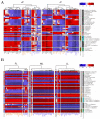Effect of Interactions between Phosphorus and Light Intensity on Metabolite Compositions in Tea Cultivar Longjing43
- PMID: 36499516
- PMCID: PMC9740319
- DOI: 10.3390/ijms232315194
Effect of Interactions between Phosphorus and Light Intensity on Metabolite Compositions in Tea Cultivar Longjing43
Abstract
Light intensity influences energy production by increasing photosynthetic carbon, while phosphorus plays an important role in forming the complex nucleic acid structure for the regulation of protein synthesis. These two factors contribute to gene expression, metabolism, and plant growth regulation. In particular, shading is an effective agronomic practice and is widely used to improve the quality of green tea. Genotypic differences between tea cultivars have been observed as a metabolic response to phosphorus deficiency. However, little is known about how the phosphorus supply mediates the effect of shading on metabolites and how plant cultivar gene expression affects green tea quality. We elucidated the responses of the green tea cultivar Longjing43 under three light intensity levels and two levels of phosphorus supply based on a metabolomic analysis by GC×GC-TOF/MS (Two-dimensional Gas Chromatography coupled to Time-of-Flight Mass Spectrometry) and UPLC-Q-TOF/MS (Ultra-Performance Liquid Chromatography-Quadrupole-Time of Flight Mass Spectrometry), a targeted analysis by HPLC (High Performance Liquid Chromatography), and a gene expression analysis by qRT-PCR. In young shoots, the phosphorus concentration increased in line with the phosphate supply, and elevated light intensities were positively correlated with catechins, especially with epigallocatechin of Longjing43. Moreover, when the phosphorus concentration was sufficient, total amino acids in young shoots were enhanced by moderate shading which did not occur under phosphorus deprivation. By metabolomic analysis, phenylalanine, tyrosine, and tryptophan biosynthesis (PTT) were enriched due to light and phosphorus effects. Under shaded conditions, SPX2 (Pi transport, stress, sensing, and signaling), SWEET3 (bidirectional sugar transporter), AAP (amino acid permeases), and GSTb (glutathione S-transferase b) shared the same analogous correlations with primary and secondary metabolite pathways. Taken together, phosphorus status is a crucial factor when shading is applied to increase green tea quality.
Keywords: Camellia sinensis; green tea; light intensity; metabolome; phosphorus.
Conflict of interest statement
The authors declare no conflict of interest.
Figures








References
-
- Jafari M., Tahmoures M., Ehteram M., Ghorbani M., Panahi F. Soil Erosion Control in Drylands. Springer; Berlin/Heidelberg, Germany: 2022. Agroforestry and Its Role in Soil Erosion Biological Control; pp. 649–700.
-
- Ji H.-G., Lee Y.-R., Lee M.-S., Hwang K.H., Park C.Y., Kim E.-H., Park J.S., Hong Y.-S. Diverse metabolite variations in tea (Camellia sinensis L.) leaves grown under various shade conditions revisited: A metabolomics study. J. Agric. Food Chem. 2018;66:1889–1897. doi: 10.1021/acs.jafc.7b04768. - DOI - PubMed
-
- Zhao S., Cheng H., Xu P., Wang Y. Regulation of biosynthesis of the main flavor-contributing metabolites in tea plant (Camellia sinensis): A review. Crit. Rev. Food Sci. Nutr. 2022. in press . - PubMed
MeSH terms
Substances
Grants and funding
LinkOut - more resources
Full Text Sources
Research Materials
Miscellaneous

